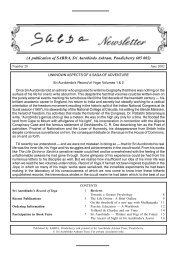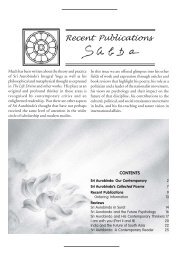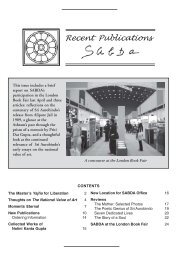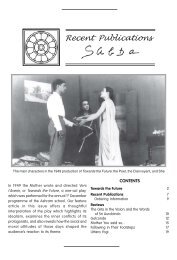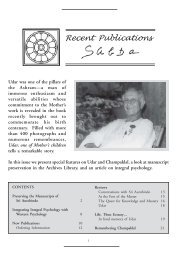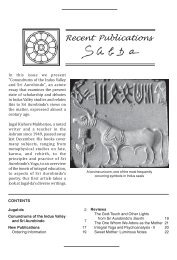18 <strong>Recent</strong> <strong>Publications</strong>an excellent corroboration of this theory in the significantparables and other relevant texts of the Upanishadslike the Brihadaranyaka, Aitareya and Kena. It briefly discusses<strong>Sri</strong> <strong>Aurobindo</strong>’s approach to the Vedas and the valueof his theory of adhyatmika interpretation. The survey isboth succinct and masterly. Through this the book successfullymakes out a case for a symbolical interpretationof the Rik Mantras.It is worthwhile to note how Professor Singh hasaccomplished his task, through a few instances culled fromhis book. First of all, there is a hymn called the Frog Hymn(7-103). It is a hymn seen by Vasistha. If we read it, we mayunderstand how the poet looks upon common creaturesand expresses his thoughtsthrough them. He uses themas symbols of things belongingto a completely differentorder of existence.Professor Singh has takenThe book successfullymakes out a case for asymbolical interpretationof the Rik Mantras.note of all important clues provided by the poet and unfoldsto us the underlying significance of the hymn. Onenotable insight he has given is this: “the ... frog after gettingitself bathed in and filled with the heavenly waterand producing the bellowing voice of cow stands for thefull-fledged seer having realised the thousand-syllabledVak and thus being in a position to make available thesame to other human beings also.” (p. 478) In this connectionhe refers to Max Müller’s comment on this hymn. Hiscomment is that the hymn is a satire on priests. Evidently,his conclusion is due to a comparison drawn between thecroaking of frogs and the recitation of the mantras bypriests. Professor Singh rejects this by saying that the comparisonis not intended to put the priests in a bad light. Hethinks that even Yaska’s interpretation of the hymn as amere prayer to frogs does not go deep and bring out itsadhyatmika aspect.To go to the second example from the book, let us referto the interpretation of another important concept, namely,the Horse Sacrifice. After a detailed study the author comesto the conclusion that the most appropriate and authenticexplanation of this sacrifice is to be found in theBrihadaranyaka Upanishad where the horse is shown“to symbolise Prajapati on the divine plane, the sun onthe physical and the Atman on the spiritual.” (p. 470)Given the relevant facts the author has collected and theorder in which he has arranged them we realise how hisconclusion is both natural and inevitable.Now we come to the third and last example. This isrelated to a mantra (1-164-20) seen by Dirghatamas. Itspeaks about two birds (dvasuparna) perched on a tree.They stand for the two realities of Brahman and Jivatman.This mantra appears in the Mundaka Upanishad (3-1-1) asa quotation. It has been elaborated by both the Veda andthe Upanishad. By studying the two elaborations, one inthe light of the other, Professor Singh rightly concludesthat the history of Indian philosophy would have followeda different course of development and produced a nonescapistview of the world, if the elaboration given by theVeda had not been neglected by the leaders of ancientIndia. There is a profound truth in this statement. Thereforeit deserves to be investigated by all scholars of Vedanta.Professor Singh’s book is both insightful and instructive.No serious student of Indian philosophy, particularly ofthe Veda, can afford to neglect this work. It will surelybe a source of unfailing help to all who are generallyinterested in the teachings of this scripture.— N. JayashanmugamProf. Jayashanmugam is a retired professor of Philosophy,Annamalai University.Remembering The Mother with GratitudeA Collection of Reminiscences; Published by<strong>Sri</strong> <strong>Aurobindo</strong> Centre for Advanced Research,Pondicherry; Price Rs. 100.00, 120 pp.The book is about the Mother’sinteraction with the children anddisciples of the <strong>Ashram</strong> from the1940s to the 1970s. As the <strong>Ashram</strong>went through different phases,the Mother’s physical proximity toher disciples either diminished orincreased. In the ’30s, she was notas much accessible to the first generationof sadhaks as she was to thechildren of the Playground in the ’40s and ’50s. ChitraSen, Aster Patel, Richard Pearson, Gauri Pinto, ShobhaMitra and Krishna Chakravarty were among those luckychildren, now grey-haired venerable disciples sharing withus their golden moments with the Mother. This period isparticularly interesting because we generally don’t associatethe Mother with athletic or gymnastic competitionsor dramatic programmes or guiding the children in theirday-to-day activities. She told them to dress up neatly, cuttheir nails short and recommended “Horlick’s malted milk”for the one-year-old Gauri Pinto. At the same time, sheinfused in them her consciousness almost without theirknowledge, so that she was a complete Mother to them. Awhole new generation grew up under the Mother’s care
<strong>Recent</strong> <strong>Publications</strong> 19during this period and what we get in this book is a sampleof the gold which is still available in plenty. I hope moreattempts are made to glean the memories of this generationbefore it is too late.The second set of recollections is by Prema Nandakumar,Georges Van Vrekhem and Varadharajan, one of the firstTamilians to settle in Auroville. Here, the Mother isphysically distant but psychologically near. She is theMother who inspires us from within. The three had only afew meetings with her but these became the turning-pointsof their lives. The story of how Prema Nandakumar(<strong>Sri</strong>nivasa Iyengar’s daughter) wrote her Ph. D. thesis, thefirst of its kind, on <strong>Sri</strong> <strong>Aurobindo</strong>’s Savitri is interesting.When the Mother came to know about it, she said, “I wantto see the girl,” and immediately gave the manuscript toAmal Kiran for publication. The description of the interviewthat followed with the Mother is profoundly moving.Vrekhem, the well-known biographer of <strong>Sri</strong> <strong>Aurobindo</strong>and the Mother, keeps us equally spell-bound by the storyof his “initiation” through two silent interviews with theMother in 1970. Varadharajan acquaints us with thebeginnings of Auroville; he was among the group ofAurovillians that met the Mother every week in 1970.This is a facet of the Mother which many in the <strong>Ashram</strong>don’t even know about. The City of Dawn is not just a goodadvertisement but a reality which was seriously discussedby the Mother with the first Aurovillians. It is another goldmine where more work should be done before the lastAurovillians who met the Mother are no more.A whole new generation grew up under the Mother’s careand what we get in this book is a sample of the gold whichis still available in plenty. I hope more attempts are made toglean the memories of this generation before it is too late.The only drawback of this book is that it is limited tothe talks given by the above mentioned persons in a seminarheld at SACAR (<strong>Sri</strong> <strong>Aurobindo</strong> Centre for AdvancedResearch, Pondicherry) on the occasion of the 125 th BirthAnniversary of the Mother. Giving a talk and listening toit is obviously different from writing an article for a bookand reading it. For, after reading the book, one is left withthe impression that many of the speakers have not saidenough, or having awakened our interest, don’t want to saymore. Or they have generalised and even intellectualised,perhaps to keep personal details in the background. I wishthey had not, for it is precisely these that the reader isinterested in. Which is perhaps why they should have beenpersuaded to say more than what they actually said duringthe seminar, when a book was going to be published.Nonetheless, the book is a commendable achievementand, I hope, many more books of this kind are produced.Let me now write a few words in support of such reminiscencesof the Mother, because of certain objectionsthat have been raised against them. The first objectionagainst them is that these memories are too personal andbeautiful to be expressed. Then, the external events are sointricately woven with the inner that it is difficult to conveythem. So many in the <strong>Ashram</strong> have thus preferred toremain publicly silent than spoil the experience with poorexpression. Meanwhile, some have over-expressed them,which has perhaps given a bad reputation to such literature.But bad literature is no argument against the attemptto produce good literature of the same genre. Moreover,the difficulty of expression can sometimes be overcomeby simply being sincere within the existing limitations oflanguage and not trying to be too perfect, because youcan never be perfect in these matters! What counts more issincerity and that carries the language, as it were, andmakes the expression adequate. The second objection isthat what the Mother told them is personal and doesn’tapply to others. To this my answer is, “The more personal,the better it is and the more interesting. And then what ispersonal? Are we not made up of the same basic universalelements?” Another reason for not sharing one’s experienceis that it might contradict another person’s version ofthe same event. Now, this is good social behaviour butbad history in the making, because many, many personal points of view are what constitute objective history.Contradictions are bound to appear in dealing with thepersonalities of <strong>Sri</strong> <strong>Aurobindo</strong> and the Mother because weare basically looking at things from the wrong end – fromthe ignorant mind, whereas they operated from above it.This does not mean that we don’t rationalise or onlyemotionalise but that we realise our limitations and notbe too squeamish about accepting only one side of theTruth. Finally, we are not looking for intellectual statementsin a book of reminiscences. It is the differencebetween reading The Life Divine and Nirodbaran’s TwelveYears or Champaklal Speaks. The former will keep usintellectually busy for the next few centuries while in thelatter we enter the sacred precincts, zoom in, and feel theliving presence of <strong>Sri</strong> <strong>Aurobindo</strong> and the Mother throughthe eyes of those who have been fortunate to be with them.— Raman ReddyRaman completed his studies at the <strong>Sri</strong> <strong>Aurobindo</strong> InternationalCentre of Education in 1975. A member of the<strong>Ashram</strong>, he works at the Archives and Research Library.His interests include writing, and he has authored a bookof short stories, A New Panorama, available with SABDA.



